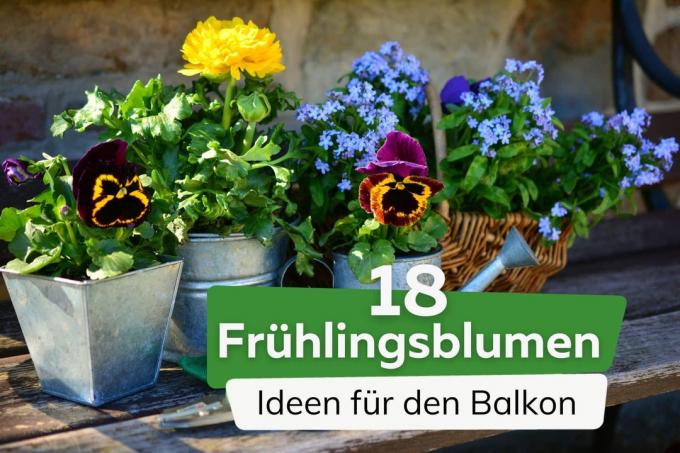
When nature comes back to life after a dreary gray winter, the outside living area should also be slowly brought out of hibernation. The most diverse spring flowers can give beautiful splashes of color on the balcony or terrace.
In a nutshell
- some flowers as early as February
- gives annual, biennial or perennial spring flowers
- Bulb and tuber plants are indispensable
- Plant tulips, daffodils and the like using the lasagne method
- Combine bushy species with bulbous plants
Table of contents
- Onion plants and Co
- Spring Flowers by G – H
- K – L
- NO
- Spring flowers for the balcony with S
- Spring bloomers for the balcony with T
- V – Z
- frequently asked Questions
Onion plants and Co
The first ones are already enchanting from February/March spring flowers the garden, balcony and terrace with their bright colors. They include not only a wide variety of bulbous plants, but also annuals, biennials or perennials spring bloomers. They can be easily combined in pots, tubs and boxes. Below is a small list of the most popular Spring flowers for the balcony:
Bergenia (Bergenia)

This is an evergreen perennial that also feels at home in pots and tubs. It is hardy, but should receive light protection in harsh conditions.
- Height: 20 to 50 cm
- heyday: March to May
- Blossoms: Flower bells in large cymes, white, red, pink
- Location: sun to shade
- Layout: Versatile, spring bloomer, in autumn combinations, ornamental foliage plant in summer
squill (Scilla siberica)

the little one onion plant delights with its dainty and colorful flowers for several weeks. After flowering, they can be transplanted into the garden.
- Height: 10 to 20 cm
- heyday: March to May
- Blossoms: blue, white, violet
- Location: Sun to semi-shade
- Layout: in combination with spring roses, primroses, daisies, pansies
Spring Flowers by G – H
gold lacquer (Erysimum cheiri)
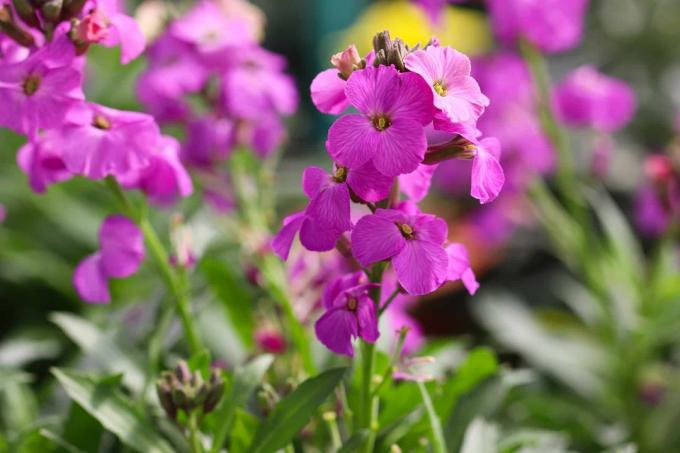
The subshrub has a bushy, upright and branched habit. The varieties “Zwerbusch” and “Bedder” are particularly suitable.
- Height: 25 to 35 cm
- heyday: April to June
- Blossoms: 2 to 3 cm in size, in racemes, single or double, honey-like scent, yellow, orange, red, brown, violet
- Location: sun up penumbra
- Layout: suitable for all spring bloomers, especially good next to blue or white blooming partners
Horned Violet (Viola cornuta)

The little sister of pansies enchants with their colorful "faces". Faded flowers should always be removed to encourage new flowering.
- Height: 10 to 15 cm
- heyday: April to July and in autumn
- Blossoms: many small, all colors, also multicolored
- Location: Sun to semi-shade
- Layout: Companion for late flowering tulips and daffodils, as well as gold lacquer
Tip: Ribbons fluttering in the wind can set even more accents in spring combinations.
hyacinth (Hyacinthus orientalis)
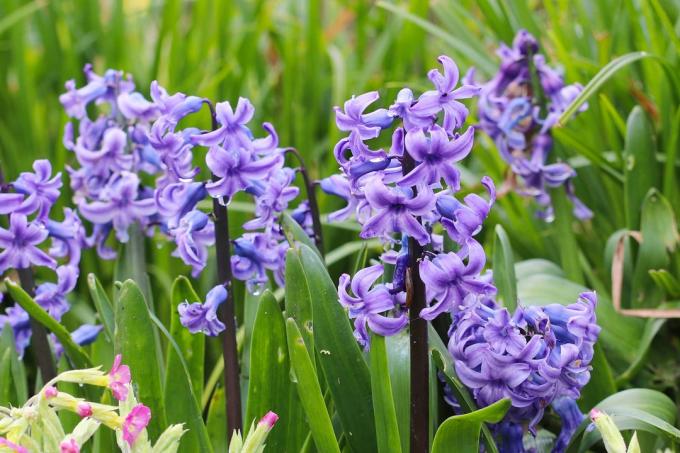
The onion plant with its beguiling fragrance not only feels at home in the garden. They add a pop of color to any bowl or box.
- Height: 20 to 30 cm
- heyday: April to May
- Blossoms: cylindrical inflorescences with dense single flowers, violet, pink, white, blue, yellow, red
- Location: Sun, sheltered from rain, slightly shaded
- Layout: goes well with herbaceous spring flowers on the balcony to cover up bare stems, forget-me-nots, primroses, pansies, daisies
K – L
cushion primrose (Primula vulgaris)
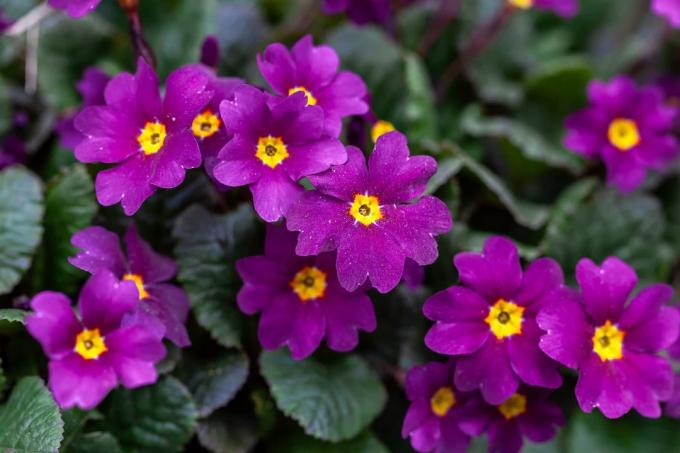
It is actually a perennial plant but is often grown as an annual. With its colorful flowers, it should not be missing in any arrangement.
- Height: 5 to 15 cm
- heyday: February to May
- Blossoms: Plate-shaped, 2 to 3 cm in diameter, in umbels, slightly fragrant, all colors, including multicolored
- Location: Sun to semi-shade
- Layout: several different colored varieties in one bowl, good neighbors are forget-me-nots, pansies, spring onions
A notice: After flowering, the primroses can be planted in the garden. They can then be cultivated for several years.
crocus (crocus)

The bulbous plant is one of the first heralds of spring. It has an upright habit with short flower stalks and grassy leaves.
- Height: 5 to 10 cm
- heyday: February to April
- Blossoms: cup- or goblet-shaped, violet, yellow, white, pink, purple, also multicolored
- Location: Sun, also tolerates light shade
- Layout: Companions to other spring bloomers, or different flower colors planted in trays or boxes
spring rose (Hellebore orientalis)

The long-lived garden perennial drives away the winter with its distinctive flowers. Even though it is beautiful to look at, the parts of the plant are poisonous.
- Height: 25 to 50 cm
- heyday: February to April
- Blossoms: Single flowers, double or slightly double, white, green, red, pink, yellow, multicolored
- Location: penumbra
- Layout: in combination with squills, hyacinths, primroses, crocuses
Tip: An eye-catcher on the balcony is also one Willow standard in a tub with an underplanting of various spring flowers such as pansies, primroses and daisies in delicate shades of pink.
NO
daffodil (narcissus)

Flowers sprout from the bulb in a cheerful shade of yellow or bright white. In order to maintain their flowering joy, they are fertilized once after the start of flowering.
- Height: 10 to 40 cm
- heyday: March to May
- Blossoms: trumpet or star-shaped, partly fragrant, yellow, white, orange
- Location: Sun to semi-shade
- Layout: plant in small groups, in combination with pansies, tulips, daisies, primroses
ranunculus (Ranunculus asiaticus)

The bulbous plant is one of the Buttercup family (Ranunculaceae). It sets imposing accents with its brightly colored flowers.
- Height: 20 to 40 cm
- heyday: March to June
- Blossom: Diameter 5 to 12 cm, densely filled, red, pink, yellow, white, orange
- Location: Sun to semi-shade
- Layout: in mixed flower colors in large bowls or in combination with daffodils, tulips, hyacinths, forget-me-nots
Spring flowers for the balcony with S
checkered flower (Fritillaria meleagris)

This onion flower is a real eye-catcher because the pattern on the distinctive flowers resembles a chessboard. But beware, the whole plant is poisonous.
- Height: 25 to 35 cm
- heyday: April to May
- Blossoms: Single flowers, terminal bells, slightly overhanging, white, red, pink, violet
- Location: Sun to semi-shade
- Layout: in combination with tulips, daffodils, hyacinths
pansies (Viola x wittrockiana)

The biennial flowers must not be missing in any spring planting. They have a compact habit with some slightly overhanging flowers.
- Height: 15 to 25 cm
- heyday: March to June and in autumn
- Blossoms: small and large flowers, all colors, also multicolored
- Location: Sun to semi-shade
- Layout: go well with tulips, hyacinths, daffodils, grape hyacinths
radiant anemone (Anemone blanda)

The spring bloomer with its filigree flowers not only sets beautiful accents in the garden. Good drainage is important when planting in pots and boxes.
- Height: 10 to 20 cm
- heyday: March to April
- Blossoms: Single flowers, radial, yellow centre, white, blue, violet, pink
- Location: Sun to semi-shade
- Layout: in combination with tulips, hyacinths, primroses or planted in a bowl
Tip: The planted spring arrangements can be loosened up with inserted branches of birch, willow, forsythia or hazelnut.
Spring bloomers for the balcony with T
dazzling (Bellis perennis)
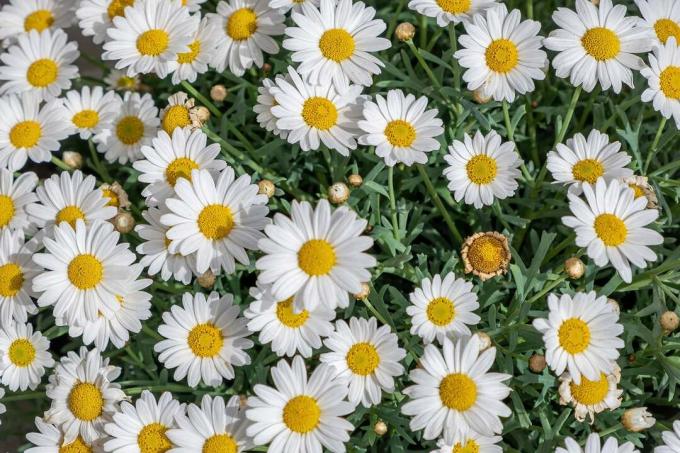
Also known as daisies or daisies, spring flowers can be planted in fall or spring. Plentiful watering is necessary on warm days.
- Height: 15 to 30 cm
- heyday: March to June
- Blossoms: terminal single flowers, white, pink, red, sometimes with a yellow centre, double or pompom-like
- Location: Sun to semi-shade
- Layout: in combination with blue spring flowers such as squills, hyacinths and grape hyacinths, primroses
grape hyacinth (muscari)

The herbaceous growing grape hyacinth can form entire carpets. For insects, the early-blooming onion is one of the first sources of food.
- Height: 10 to 25 cm
- heyday: March to April
- Blossoms: Single flowers in racemes, blue, white, also bicolored
- Location: Sun to semi-shade
- Layout: Planted in small groups in pots or in combination with daisies, tulips, pansies, horned violets, daffodils
tulips (Tulpia)
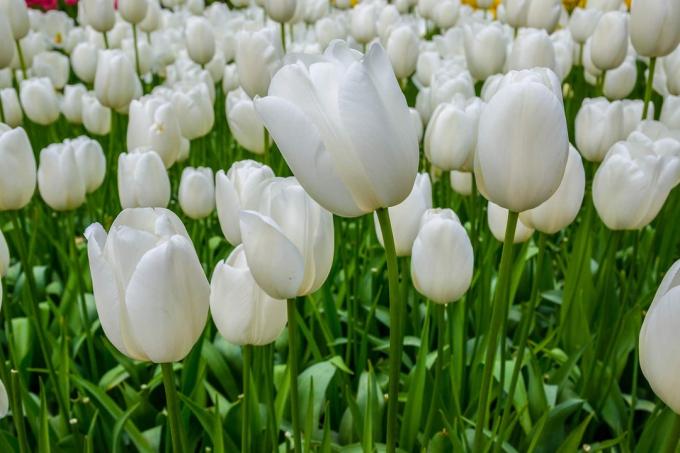
These distinctive bulbous plants should not be missing in any spring planting. Low flowering wild tulips are particularly attractive.
- Height: 10 to 40 cm
- heyday: March to May
- Blossoms: calyx, - funnel- to bell-shaped, wild tulips spread out in a star shape, partly fragrant, all colors, also multicolored
- Location: Sun to semi-shade
- Layout: put in small groups of 4 to 5 pieces, in combination with daffodils, forget-me-nots, squills, crocuses, grape hyacinths, primroses
V – Z
forget Me Not (myosotis)
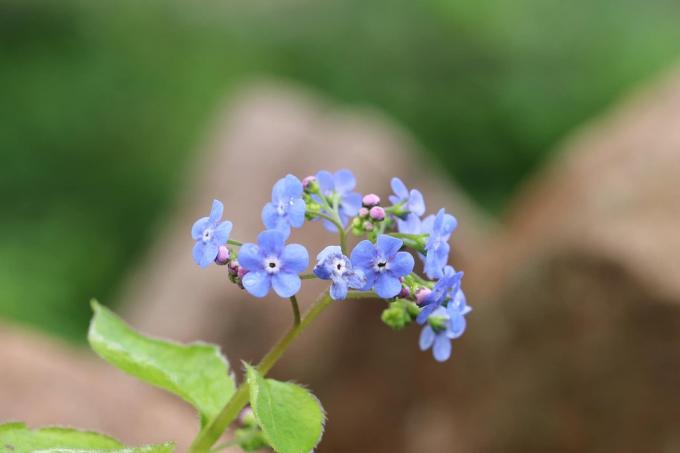
This profusely blooming borage family brings a lightness to every spring planting. It is very frugal, only needs plenty of watering on warm days.
- Height: 15 to 25 cm
- heyday: April to June
- Blossoms: many small single flowers, in dense clusters, shades of blue, pink and white
- Location: partial shade, cool
- Layout: in combination with spring bulbs such as tulips, daffodils, also in the vicinity of daisies, daisies, primroses, pansies
dwarf iris (Iris reticulata)

The dwarf iris shows its small flowers early in the year. They attract with their subtle scent bumblebees and wild bees.
- Height: 10 to 20 cm
- heyday: February to March
- Blossoms: terminal single flowers, violet, blue, white
- Location: Sun to light semi-shade
- Layout: Plant in small groups or in combination with crocuses, snowdrops, spring roses, primroses
frequently asked Questions
Bulbs and tubers that have already been planted can be planted in pots in the spring. The planting should be done in groups of three, so that a correct color effect occurs. The distance can be quite narrow. In addition, onions or tubers can also be planted in autumn. Here, the recommended planting distance must be observed so that the plants can develop well.
By regularly cleaning out faded flowers, the plants are prevented from forming seed heads. They can then use all their strength to form new flowers. When seed formation occurs, the plant stops flowering.
Here, flower bulbs are planted in layers in tubs. These must have good drainage made of gravel or expanded clay and a drainage hole. Late flowering and large species such as tulips and daffodils are placed in the bottom layer. They are covered with earth. In the next layer, hyacinths, grape hyacinths and daffodils are planted and covered with soil. Crocuses, dwarf irises and squills are planted in the last layer. Autumn plants can find their place on top.



